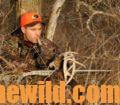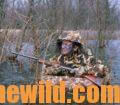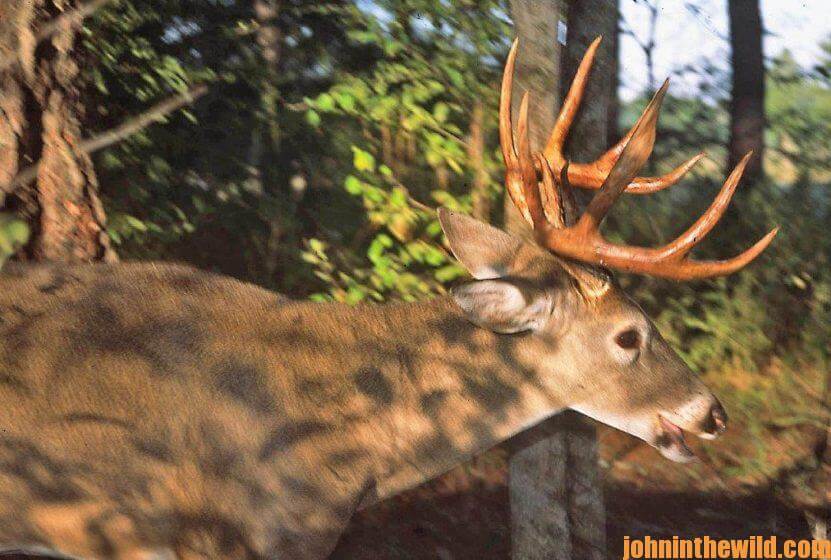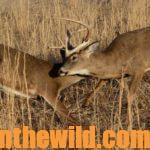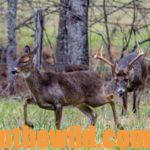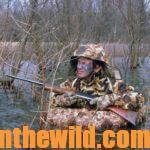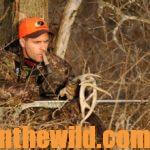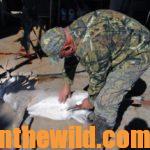Editor’s Note: If hunters will be really honest, sitting 4-5 days in a deer stand when the deer aren’t moving is about as much fun as watching paint dry or maple sap coming down a tree and dripping in a bucket to make maple syrup. But these days can happen. I’m including this week the latest information on hunting deer to help you be more successful: why hunt small properties; why hunt your deer from the skinning shed; how to talk to a buck; and what deer tracks can tell you, besides some of my family’s favorite venison recipes. Luckily several places I deer hunt have potholes where the water collects during the fall or sloughs coming off the main rivers and running through oak bottoms with plenty of acorns floating on top of the water. So, when I tire of hunting deer, and after I’ve watched ducks fly into places like this for 3-4 days and not seen any deer, I’ll let the deer rest. I’ll my shotgun and my waders out of the trunk of my car and wear out those ducks.
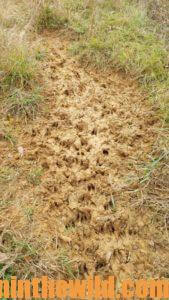 Deer Tracks:
Deer Tracks:
Through the years in any hunting camp I’ve ever been in, a track expert, who can tell the size, sex and age of a deer by its tracks, always seems to have been in residence. I’ve stalked deer before that the width of their tracks has convinced me they’re bucks. Also I’ve had hunters tell me that seeing the dew claws as part of the deer track is a definite indication that the animal making the track is a buck. Because so much misinformation exists about deer tracks, and what information they can communicate to hunters, I’ve talked to wildlife biologists and avid deer hunters to learn the truth about deer tracks.
Like you, I’ve known hunters who’ve said, “I saw the track of Ole Mossy Horns down by the creek last Thursday. I’m sure that’s him, because I’ve examined his track for the last three years. He’s got a very-big track. One of these days I’m going to find him standing in it.”
 However, retired wildlife professor Horace Gore is skeptical about a hunter’s ability to determine that one particular track has been made by the same deer year after year. “If the deer’s track is exceptionally big, you may be able to say year after year that the same deer made the track. But the deer will have to be an unusually-large deer. Deer tracks don’t mean that much in helping to denote one deer from another, when the ground’s dry and hard. You may have a better chance of distinguishing a specific deer’s track from another in places like South Carolina, where much of the ground is soft. Still the deer must have an unusual track – perhaps crippled in some way or a somewhat different-looking foot – to be discernible. Identifying deer by their dropped antlers is a more effective way to do that.”
However, retired wildlife professor Horace Gore is skeptical about a hunter’s ability to determine that one particular track has been made by the same deer year after year. “If the deer’s track is exceptionally big, you may be able to say year after year that the same deer made the track. But the deer will have to be an unusually-large deer. Deer tracks don’t mean that much in helping to denote one deer from another, when the ground’s dry and hard. You may have a better chance of distinguishing a specific deer’s track from another in places like South Carolina, where much of the ground is soft. Still the deer must have an unusual track – perhaps crippled in some way or a somewhat different-looking foot – to be discernible. Identifying deer by their dropped antlers is a more effective way to do that.”
Longtime wildlife biologist Bob Zaiglin says that seeing the deer that has made the track is far-more important than looking at a track and attempting to determine anything about the animal. “The main function tracks perform is to notify you that a deer has walked through this place at some time in the past. Discovering deer tracks is no guarantee that the same deer will walk back through that region again. Generally deer tracks don’t tell you the sex or the size of the deer. Much of the information about deer tracks are old wives’ tales we’ve heard. But deer tracks are only suppositions and good conversation fodder for campfire talk.”
Deer During the Rut:
Here’s what some of the nation’s most well-known deer hunters and researchers say about hunting the rut.
* The Lie about Does:
Wildlife biologist Dr. Grant Woods says, “Hunters often have the misconception that they shouldn’t harvest many does to have more bucks on their lands during the rut. However, studies following bucks wearing GPS collars show the inaccuracy of this idea of bucks leaving their home ranges with low doe numbers and moving to another property with high doe numbers. Evidence indicates that once a buck sets up his home range, his world consists of that home range. Within that range is his core area where he feels very secure and has plenty of food and water. He does interact socially with other deer within his home range, which I define as everywhere a deer goes within a year’s time.” Biologists have found that a buck may move out of his home range during the rut if numbers of older-age-class bucks live on the same range. Subordinate bucks realize they’ll only get to breed an estrous doe if they leave their home ranges.
* Another Lie about the Rut:
For many years, hunters have believed that bucks mark their territory using scrapes and rubs. But Woods thinks scrapes and rubs in deer country have nothing to do with a deer’s territory. “They’re signposts where deer leave messages for other deer, and bucks won’t protect their scrapes and rubs or fight at them. During the rut, a buck only will defend about 20 yards around an estrous doe.”
* The Importance of Trails, Thick Cover and Funnels:
Well-known deer hunter Ernie Calandrelli of New York, hunts white-tailed deer regularly on his friend’s Georgia property. He locates big bucks during the rut on the trails between feeding and breeding sites. “Bucks know that does must eat and bed down, and these places are the most likely spots for them to discover the most does. You may encounter an older-age-class buck in a funnel area where two woodlots are pinched-down into a bottleneck. Because bucks have to be on the move during the rut, they’ll be chasing does on both ends of the funnel. You’re more likely to see bucks passing through a funnel at any time of the day during the rut. Hunting the thickest cover where bucks hole up also pays off.”
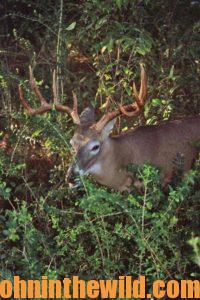 Dr. Larry Marchinton, a retired professor of wildlife, from the University of Georgia, probably has written more on deer behavior and movement than anyone. “If I only had one place to hunt during the rut, I’d hunt funnel areas. Funnel areas are productive at any time of the year, but tend to be the most productive during the rut when bucks are on the move and searching for does to breed. To go from one woodlot to another, the bucks will move through a funnel. If you’re there, you can take him.”
Dr. Larry Marchinton, a retired professor of wildlife, from the University of Georgia, probably has written more on deer behavior and movement than anyone. “If I only had one place to hunt during the rut, I’d hunt funnel areas. Funnel areas are productive at any time of the year, but tend to be the most productive during the rut when bucks are on the move and searching for does to breed. To go from one woodlot to another, the bucks will move through a funnel. If you’re there, you can take him.”
Recipe: Five Hour Venison Stew
The ease of preparing and cooking this flavorful stew will surprise you. Serve it with hot bread or cornbread and baked brown sugar, cinnamon apples. This meal is even more delicious as a leftover.
Ingredients:
3 packages of frozen stew vegetables (contains carrots, potatoes, celery and onions ready for use, which will save time)
or
6 carrots, sliced
3 celery stalks, chopped
2 large potatoes, chopped
1 large onion, preferably purple, chopped
3 frozen seasoning packs that include onions, bell peppers and celery chopped very fine or fresh seasonings chopped
2 pounds venison cubes, cut in 1-inch chunks and presoaked in salty water overnight in the refrigerator and then rinsed thoroughly
2 (14-1/2-ounce) cans stewed tomatoes (to spice it up use one can of Rotel tomatoes)
4 tablespoons Tapioca pudding (if can’t find can use vanilla instant pudding)
Salt to taste
Cracked black pepper to taste
Preparation:
Place all ingredients in a large, covered baking dish or oven-proof Dutch oven for 5 hours on 250 degrees. Don’t open the oven or take the cover off the dish to check the progress of this stew. Just cook until done, and remove it from the oven.
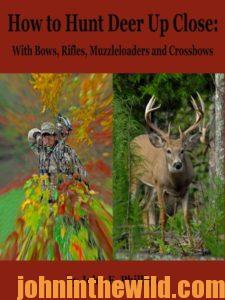
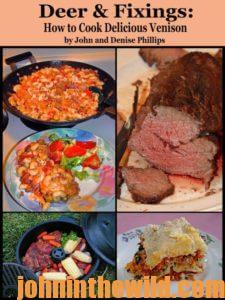 To learn more about hunting deer, check out John E. Phillips’ book, available in Kindle, print and Audible versions, “How to Hunt Deer Up Close: With Bows, Rifles, Muzzleloaders and Crossbows” (http://amzn.to/11dJRu8). You may have to copy and paste this click into your browser. (When you click on this book, notice on the left where Amazon allows you to read 10% of the book for free and listen to 10% for free). Also check out “Deer & Fixings” cookbook, available at http://amzn.to/WGaJLT.
To learn more about hunting deer, check out John E. Phillips’ book, available in Kindle, print and Audible versions, “How to Hunt Deer Up Close: With Bows, Rifles, Muzzleloaders and Crossbows” (http://amzn.to/11dJRu8). You may have to copy and paste this click into your browser. (When you click on this book, notice on the left where Amazon allows you to read 10% of the book for free and listen to 10% for free). Also check out “Deer & Fixings” cookbook, available at http://amzn.to/WGaJLT.
Tomorrow: Why Taking Ducks Without a Boat Isn’t a Problem

